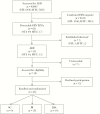Randomized Controlled Pilot Study of Antiretrovirals and a Behavioral Intervention for Persons With Acute HIV Infection: Opportunity for Interrupting Transmission
- PMID: 30648131
- PMCID: PMC6329906
- DOI: 10.1093/ofid/ofy341
Randomized Controlled Pilot Study of Antiretrovirals and a Behavioral Intervention for Persons With Acute HIV Infection: Opportunity for Interrupting Transmission
Abstract
Background: Persons with acute HIV infection (AHI) have heightened transmission risk. We evaluated potential transmission reduction using behavioral and biomedical interventions in a randomized controlled pilot study in Malawi.
Methods: Persons were randomized 1:2:2 to standard counseling (SC), 5-session behavioral intervention (BI), or behavioral intervention plus 12 weeks of antiretrovirals (ARVs; BIA). All were followed for 26-52 weeks and, regardless of arm, referred for treatment according to Malawi-ARV guidelines. Participants were asked to refer partners for testing.
Results: Among 46 persons (9 SC, 18 BI, 19 BIA), the average age was 28; 61% were male. The median viral load (VL) was 5.9 log copies/mL at enrollment. 67% (10/15) of BIA participants were suppressed (<1000 copies/mL) at week 12 vs 25% BI and 50% SC (P = .07). Although the mean number of reported condomless sexual acts in the past week decreased from baseline across all arms (1.5 vs 0.3 acts), 36% experienced incident sexually transmitted infection by 52 weeks (12% SC, 28% BI, 18% BIA). Forty-one percent (19/46) of participants referred partners (44% SC, 44% BI, 37% BIA); 15 of the partners were HIV-infected.
Conclusions: Diagnosis of AHI facilitates behavioral and biomedical risk reduction strategies during a high-transmission period that begins years before people are typically identified and started on ARVs. Sexually transmitted infection incidence in this cohort suggests ongoing risk behaviors, reinforcing the importance of early intervention with ARVs to reduce transmission. Early diagnosis coupled with standard AHI counseling and early ARV referral quickly suppresses viremia, may effectively change behavior, and could have tremendous public health benefit in reducing onward transmission.
Keywords: HIV; Malawi; acute HIV infection; motivational interviewing; transmission.
Figures



References
-
- Fiebig EW, Wright DJ, Rawal BD, et al. . Dynamics of HIV viremia and antibody seroconversion in plasma donors: implications for diagnosis and staging of primary HIV infection. AIDS 2003; 17:1871–9. - PubMed
-
- Pilcher CD, Shugars DC, Fiscus SA, et al. . HIV in body fluids during primary HIV infection: implications for pathogenesis, treatment and public health. AIDS 2001; 15:837–45. - PubMed
Grants and funding
LinkOut - more resources
Full Text Sources
Miscellaneous

